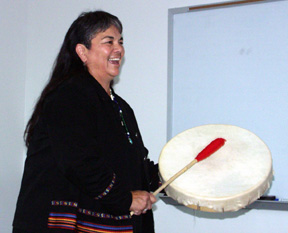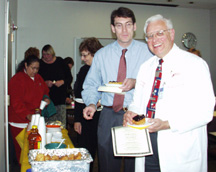 Contrary to belief, most Native Americans in Nebraska live in urban areas, said Carolyn Fiscus, director of Community Outreach and Native American Studies at the University of Nebraska at Omaha.
Contrary to belief, most Native Americans in Nebraska live in urban areas, said Carolyn Fiscus, director of Community Outreach and Native American Studies at the University of Nebraska at Omaha.
Fiscus, a member of the Winnebago Tribe of Nebraska, was at UNMC earlier this month to provide an urban native perspective on Native Americans. The NHS/UNMC Employee Diversity Network sponsored the forum in recognition of Native American Heritage Month in November.
“Most people assume native folks live on the reservation, but there are people all around us who are native,” Fiscus said.
According to the 2000 census, there are 24,000 native people in Nebraska, Fiscus said. The majority live in urban areas and roughly 7,000 live on one of the state’s four Indian reservations. In addition, there are more than 77 tribal entities represented in Omaha alone, she said.
Fiscus grew up in rural Iowa and went on to graduate from South Dakota State University with her bachelor’s and master’s degrees in health, physical education and recreation. She earned an education specialist degree in educational administration from Northwest Missouri State University and has done doctoral work in curriculum and instruction at Northern Arizona University.
“I’m trying to change the face of contemporary Native American urban people,” Fiscus said. “We’re every shape, size, color and multi-racial.”
 Identity challenges are often greater for those living off the reservation, Fiscus said. “We’re trying to recapture who we are as human beings and keep our children close to our culture,” she said.
Identity challenges are often greater for those living off the reservation, Fiscus said. “We’re trying to recapture who we are as human beings and keep our children close to our culture,” she said.
In order to improve society, as well as the abysmal graduation rates of native children, “we have to strengthen the family and pass on instruments of healing to our children,” Fiscus said. “My generation is really the first one in which it’s cool to be an Indian.”